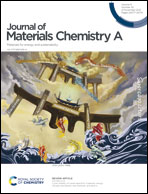The cascade catalysis of the porphyrinic zirconium metal–organic framework PCN-224-Cu for CO2 conversion to alcohols†
Abstract
Reproducing the highly efficient catalytic cascade system to mimic life behaviors in vitro has been intensively investigated over the past few decades. However, except for biocatalysis with enzymes, most chemocatalytic cascades in essence combine several reactions that occur over mutually independent catalytic sites in a container. Herein, with a series of control experiments and stepwise theoretical derivation based on the calculations of density functional theory and a semi-empirical method, a generalized cascade catalysis is discovered for the chemocatalytic conversion of CO2 to higher alcohols over a porphyrinic zirconium metal–organic framework, PCN-224-Cu. Two types of catalytic sites in PCN-224-Cu, i.e., the Zr6 cluster and TCPP-Cu unit, act like organelles, which can complete a class of reactions instead of particular one. The Zr6 cluster is in charge of molecular dissociation, while the TCPP-Cu unit is responsible for molecular assembly. Therefore, semi-finished intermediates repeatedly transfer between the two types of catalytic sites until the ultimate formation of ethanol with high efficiency (ethanol yield, 4.53 mmol h−1 gcat.−1 at 403 K) and selectivity (∼100%).



 Please wait while we load your content...
Please wait while we load your content...